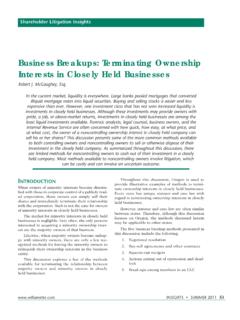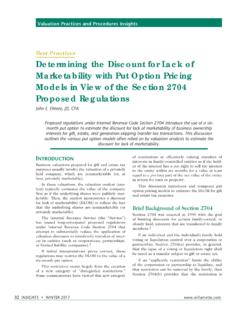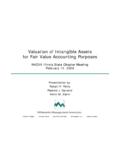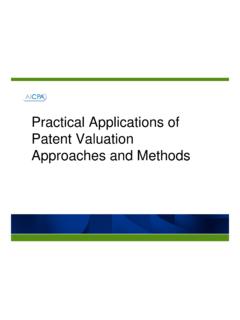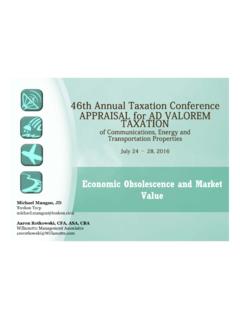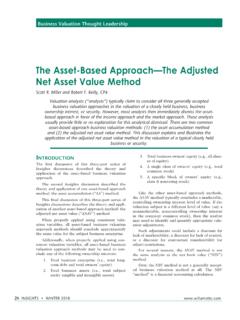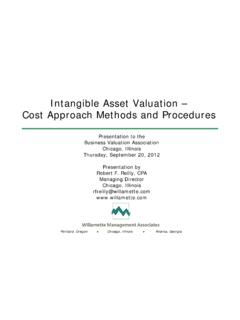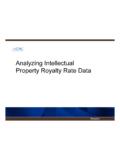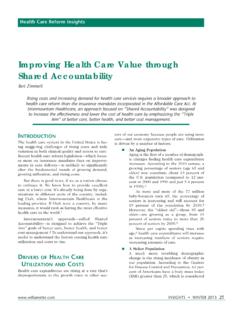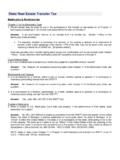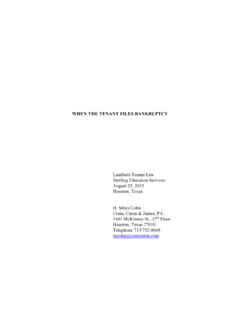Transcription of Insolvency Procedures under Section 108
1 INSIGHTS SPRING 2012 63 Insolvency Procedures under Section 108 Irina Borushko and Urmi SampatIncome Tax Insolvency InsightsIn the current prolonged recession, many industrial and commercial entities have had to restructure their outstanding debt. Many debtor entities have had to restructure their public bonds as well as their private mortgages and notes. In particular, many real estate-intensive debtor entities have had to restructure their commercial real estate mortgages. When any amount of debt repayment is forgiven in such a debt restructuring, that event causes the debtor entity to recognize cancellation of debt (COD) income for federal income tax purposes. However, the debtor taxpayer can exclude some, or all, of this COD income to the extent that the debtor entity is insolvent. This discussion summarizes the federal income tax requirements related to the debtor entity recognition of COD income.
2 And, this discussion summarizes the federal income tax requirements for the exclusion of COD income recognition related to debtor entity Insolvency . In particular, this discussion focuses on the generally accepted methods and Procedures that the valuation analyst may use to measure debtor entity Insolvency for COD income exclusion onThe 2008 credit crisis, the subsequent recession, and the sluggish recovery have negatively affected both individuals and businesses operating in most industries. The current economic downturn has affected businesses regardless of their business structure or income tax status ( , C corporation, S corporation, partnership, limited liability com-pany, etc.).During the last four years, many businesses have had to negotiate some discharge of indebtedness with their creditors. Recapitalization and restruc-turing of commercial mortgages and other corporate debt is often necessary in order for distressed busi-nesses to continue to the prolonged economic downturn, many debtor entities have to:1.
3 Renegotiate the terms of their debt or2. restructure their downside of debt restructuring is that the debtor entity may have to recognize cancellation of debt (COD) income for federal income tax purposes. If the taxpayer entity is relieved of debt, that relief is taxable income. Internal Revenue Code Section ( Section ) 61(a)(12) provides that gross income includes income from Income recognITIon excePTIonsSection 108, however, provides exclusion provisions for the recognition of COD income. Such exclusions include:1. the bankruptcy exception and2. the Insolvency is an important income tax benefit to busi-nesses seeking bankruptcy protection. Insolvent taxpayers are allowed to exclude COD income in order to:1. preserve the debtor s fresh start and2. not bear the burden of an immediate tax liability when the debt is INSIGHTS SPRING 2012 debt restructuring a common occurrence in the current economic environment, business taxpayers should:1.
4 Be aware of the COD income recognition tax rules and2. plan for the income tax effects of these debt restructuring discussion focuses on the income tax con-sequences of Section 108 related to debt restruc-turing and the exclusion of COD income due to Insolvency . This discussion summarizes the Procedures that the valuation analyst should consider with respect to measuring debtor entity Insolvency for COD income exclusion res TrucTurIng eVenTs ThaT cause debTor enTITy cod IncomeA debt restructuring outside of bankruptcy generally occurs when:1. an ownership change is not expected or 2. the parties do not want to pay the expense of a bankruptcy company may repurchase its existing debt at a price discount by means of a debt restructuring or a debt recapitalization. A nonbankruptcy debt workout may involve the creditors exchange of the debtor entity s recourse or nonrecourse debt for newly issued business owners are often required to personally guarantee the business debt in many closely held and family-owned businesses.
5 When the business becomes financially distressed, this debt is often partially or entirely debt is forgiven or partially discharged, under Section 61, COD income in the amount of the debt discharge is included in the entity s taxable income. This is because the taxpayer entity did not include the loan proceeds in income when the pro-ceeds were reduction in liabilities without a correspond-ing reduction in assets is a discharge of indebted-ness income. Essentially, COD income quantifies the economic improvement in the debtor entity s position after a restructuring example, if a creditor forgives a $200,000 debt, the taxpayer debtor will generally recognize $200,000 of taxable income, improving the entity s debt position by $200, frequently require compensating securi-ties, such as preferred stock or common stock war-rants, as an incentive for restructuring Exchange of Equity for DebtUnder Section 108, in debt restructuring that involves the exchange of equity for debt, the amount of COD income recognized is equal to.
6 The excess of the amount of the debt that is forgivenoverthe fair market value of the equity exchanged in order to cancel the debtThe more complex capital structure of the entity post-restructuring may require more complex calcu-lations to estimate the amount of the COD income. In order to estimate the economic improvement in the entity s debt position following the debt restruc-turing, the equity securities issued as compensation to the creditor need to be Section 108(e)(2), the discharge of debt will not result in COD income to the extent that payment of the liability would have resulted in a tax owed to trade creditors and certain liabil-ity claims that are discharged will also not result in COD income is considered ordinary income under Section 62(a)(12). At the time of the debt discharge, the COD is subject to federal income INSIGHTS SPRING 2012 65 COD Income Recognition ExceptionsHowever, Section 108 provides several exceptions to the COD income recognition rule, allowing exclu-sion of the COD income recognition in the following circumstances:1.
7 The taxpayer entity is in a Title 11 bank-ruptcy proceeding2. The taxpayer entity is insolvent immedi-ately prior to the forgiveness of debtCongress reasoned that these exclusions allow the taxpayer entity to get a fresh start. Also, Congress reasoned that burdening the taxpayer entity with a large income tax liability from the relief granted by the bankruptcy process or from the discharge of debt would tend to defeat that exclusion provisions under Section 108 that may be applied to COD income include the following:1. The discharge of qualified farm indebted-ness2. In the case of a business taxpayer other than a C corporation, the discharge of quali-fied real property business indebtedness3. The discharge of qualified principal resi-dence indebtedness prior to January 1, 2012debTor enTITy Insolvency reduces The recognITIon oF cod IncomeSection 108 determines what portion of the related COD income is excluded from gross income, based on the taxpayer entity s Insolvency at the time of Section 108(a)(3), if the debt discharge occurs when the taxpayer debtor is insolvent, then the amount of COD income excluded will not exceed the amount by which the taxpayer debtor is amount of COD income excluded under this Section is applied to reduce the tax attributes of the taxpayer debtor entity s tax position is affected by the COD income whether or not any income is actually realized.
8 The taxpayer entity may exclude the COD income under Section 108(a) at the cost of decreas-ing certain debtor entity tax Tax AttributesTo the extent that the taxpayer entity excludes any COD income from gross income, a corresponding reduction is applied to the income tax attributes of the subject debtor entity in the following order:1. Net operating losses (NOLs)2. General business tax credits3. Minimum tax credits4. Capital loss carryovers5. Income tax basis reduction6. Passive activity loss and credit carryovers7. Foreign tax credit carryovers under Section 108(b)(5), the debtor entity also has the option to elect to reduce the basis of its depreciable property prior to reducing any other entity tax ExampleFor example, let s consider the following illustrative scenario:1. The debtor entity has a NOL balance of $200, The debtor entity has an implied $200,000 COD income from debt No exclusion of COD income is debtor entity may use the NOL balance against the COD income.
9 Thereby, the debtor entity will decrease the realized COD income to $0. As a result, the debtor entity s tax attributes are reduced by $200, the debtor entity in the above scenario is insolvent under Section 108(a)(1)(B) by $200,000, then the implied COD income and the realized COD income are $0. However, due to Section 108(b), the debtor entity s tax attributes are still reduced by $200, Section 108 COD income recognition excep-tions are applied differently for partnerships and , it is important to consider the type of the taxpayer business entity for purposes of the Insolvency Income recognITIon For dIFFerenT busIness sTrucTures under Section 61, COD income is considered ordinary income and is subject to federal income 66 INSIGHTS SPRING 2012 at the time the debt is released. However, these tax repercussions are different for entities depending on whether the subject business is an S corporation, C corporation, or a tax effects further vary based on whether the debt is related to (1) a recourse loan or (2) a nonrecourse CorporationsWhen an S corporation recognizes COD income, this causes a reduction in the entity s tax attribu-tions at the corporation level.
10 Since S corporations do not have NOLs, this affects each shareholder s distributive share of losses and deductions that have been excluded for the taxable year of the debt result of this calculation is a readjustment of each shareholder s excess losses that carry forward into the years following the year of debt discharge. Further, if the S corporation s liabilities are can-celled, then the COD income will not be included in the S corporation s taxable income. In that case, the shareholder s financial status is not CorporationsWhen a C corporation recognizes COD income, this also results in a reduction of the entity s tax attribu-tions at the corporation level. The difference here is that C corporations do have NOLs. Therefore, the taxpayer intent typically is to preserve those NOL tax the event that a partnership defaults on its debt obligations, and a portion or all of that debt is released from the creditor, then the partnership must recognize COD income.
